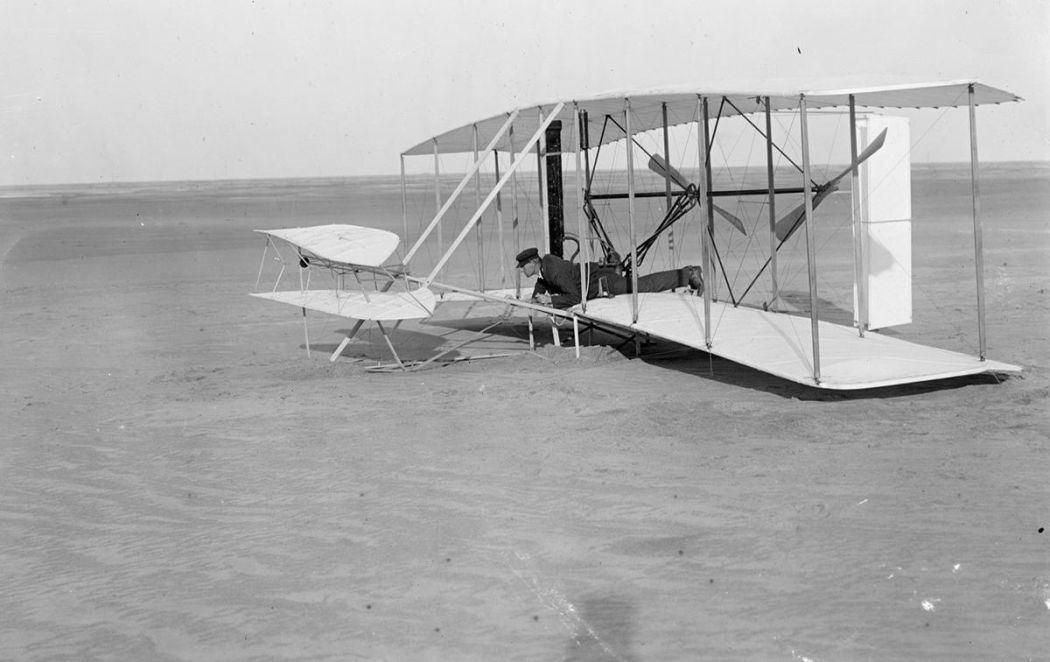Leeham News and Analysis
There's more to real news than a news release.
Bjorn’s Corner: Aircraft drag reduction, Part 9
December 15, 2017, ©. Leeham Co: In the last Corner, we described how the Wright Brothers developed the first theory for propellers. It was based on their wing work and allowed them to design an efficient pair of propellers for their 1903 Wright Flyer.
We will now describe their first propelled flights, December 1903, and prepare for looking at the lift and drag of the aircraft.

Figure 1. The Wright Flyer is prepared for flight at Kitty Hawk, 17th December 1903. Source: Wright-Brothers.org.
Preparation for first flight
The Wrights produced all the parts for the Wrights Flyer during spring and summer 1903. The aircraft was never built in Dayton. Rather, all the parts were sent in crates to the seaside dunes of Kitty Hawk, North Carolina. One needed the constant seaside winds for the flight and the soft sand dunes for any crash landings.
The brothers arrived at Kitty Hawk 25 September 1903. After the crates arrived two weeks later, they began the assembly of the aircraft. They used October for assembly and November for testing the engine and its propellers. There were problems to solve. Propeller shafts broke and the engine didn’t run cleanly.
The race with Langley
Samuel Langley was awarded $50,000 to build “a flying machine” by the War Department, after his successful model Aerodrome flights of 1896. By October 7, 1903, his full-scale Aerodrome was loaded onto the catapult of the houseboat on the Potomac River and launched.
It flew straight into the river ahead of the houseboat. Its pilot wasn’t hurt and by December 8, the Aerodrome was repaired and a second launch was made. This time it crashed after the rear wing collapsed at the launch. Langley had failed.
Langley was aware of the Wright’s whereabouts and tried to get invited to Kitty Hawk to understand what they were doing. He was especially interested in their control methods (the Aerodrome had an inefficient Penaut tail for control). The Wrights didn’t respond to the sudden interest from Langley. His telegram and letters went unanswered.
The first flight
November was windy and not suited for flight. On December 17, everything was ready. The Wrights had built a wooden rail to get the Flyer into the air from the sand.
Orville was at the controls, as Wilbur had stalled the Flyer directly after take-off three days earlier (height was negligible, so no damage to the Flyer). At 10.35 in the morning, Orville managed to fly for 12 seconds and 120ft (36m), Figure 2.

Figure 2. Orville taking off for the first flight with Wilbur running beside. Note the wood launch rail. Source: Wikipedia.
Later in the day, three more flights were made, with the longest lasting 60 seconds and covering 850ft (250m). The era of manned flight had begun.
The aerodynamics of the 1903 Flyer
We will examine the aerodynamics of the Wright’s 1903 aircraft over the next Corners and explain what was understood of the aerodynamics at the time (Figure 3).

Figure 3. The Wright Flyer’s configuration, with the pilot lying down; controlling the aircraft with the left hand (pitch), hips (roll) and feet (yaw). Source: Wright-Brothers.org.
We will discuss the lift generated, the overall drag and then divide this into the basic types of aircraft drag and how these were gradually discovered and understood.



Looking forward to the next corner 🙂
Yes
I don’t think the Wrights used a catapult to launch their airplanes until the 1905 flights at Huffman Prairie in Ohio. The 1903 Kitty Hawk flights were unaided by any mechanical assist, although they did require the stiff winds found there.
Thanks 787cape,
Figure 2 is very high res and there is what I construed as the cross-beam of a wire catapult at the end of the rail. But it might be something else. You are most probably right. The strong seaside wind probably lifted the Flyer of its rail with Wilbur and a helper holding it at the wingtips, then the motor propelled it forward slowly with Wilbur guarding the wingtip against dipping in the sand.
When researching how the flyer started I came across this lowly Nova clip which shows how difficult these machines were to fly:
https://www.youtube.com/watch?v=w2J4FQToGeg
We’ll talk more about this in the next Corner.
Surprisingly old pilot for one so bold!
Does anyone know?? what was the AIR speed of the flyer as the ground speed was on the order of 10 mph, clearly much to slow to fly in still air. This is essentially asking: What headwind were they flying into that day?